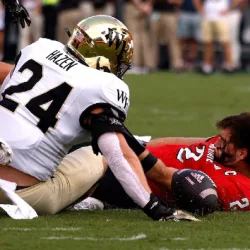
(NEW YORK) — The back-to-back retirements of two college quarterbacks seemingly at the start of their careers has put a spotlight again on concussions and youth sports, particularly football.
On Oct. 23, North Carolina State quarterback Grayson McCall announced on Instagramthat he would retire from the sport after being carted off the field in an Oct. 5 game that saw him lose his helmet in a hit.
“As you all know I have battled injuries my whole career, but this is one that I cannot come back from. I have done everything I can to continue, but this is where the good Lord has called me to serve in a different space,” McCall, 23, wrote alongside photos of him playing football as a young kid. “Brain specialists, my family, and I have come to the conclusion that it is in my best interest to hang the cleats up.”
Just five days later, on Oct. 28, University of Michigan quarterback Jack Tuttle announced that he too is retiring from football, also citing medical reasons.
Tuttle, a seventh-year senior, underwent surgery on his throwing arm in the offseason, according to ESPN, and then this season suffered the fifth concussion of his career.
“Unfortunately, the recent experience of enduring my fifth concussion has brought forth the painful truth: that I need to start prioritizing my health,” Tuttle, 25, wrote, in part, in an Instagram post announcing his retirement. “Throughout my college career, I’ve battled numerous injuries, culminating in this difficult choice to step away from playing the game that I love.
Both Tuttle and McCall noted that they planned to stay involved with football through coaching, with McCall writing, “I look forward to taking my passion and love for the game into the coaching space to serve and lead the next group of kids with a dream.”
Whether it’s safe for young kids to dream of playing football is a conversation starting again in the wake of the quarterbacks’ retirements, as well as the recent deaths of two youth football players.
Among youth sports, boys’ football has the highest rate of concussion, with10.4 concussions per 10,000 athlete exposures, according to a 2019 study published in the journal Pediatrics. Girls’ soccer and boys’ ice hockey followed behind with the second and third highest rates, respectively.
For kids who start playing tackle football at a young age, the concussions can start just as young. A 2018 study found that 5% of youth football players ages 5 to 14 suffer a football-related concussion each season.
And the science shows that each concussion — caused by a jolt to the head or a hit to the body — matters.
While not usually life-threatening, the effects of even a mild traumatic brain injury (TBI) or concussion, can be “serious,” according to the U.S. Centers for Disease Control and Prevention, causing changes to the brain that can impact a kid’s sleep, learning, behavior and thoughts.
Over time, repeated concussions can cause long-term problems with concentration, memory, balance and headaches, according to the CDC.
Chris Nowinski, Ph.D., co-founder and CEO of the Concussion Legacy Foundation, a nonprofit organization focused on concussion and CTE research, told ABC News that while he doesn’t know the specifics of Tuttle’s and McCall’s, it’s notable that they retired from football now, during their college careers.
“It’s important remember, you only get one brain, and when you’re playing football, you’re risking your long-term brain health,” Nowinski said. “And so you want to make sure that when you get warning signs that your brain is losing its resilience to trauma, you shut it down before it gets too bad.”
He added of Tuttle and McCall, “They’re better off finding that new passion versus running their brain to the ground and dealing with those consequences for the rest of their lives.”
Takeaways for parents and young athletes
Nowinski said he recommends that if a child is interested in playing football, they play flag or touch football instead of tackle football for as long as possible.
It’s a recommendation echoed by the CDC, which cites data showing youth tackle football players had 15 times more head impacts during a practice or game than flag football athletes.
If a child is playing tackle football, safety recommendations from the CDC include reducing the number of contact practices for teams, teaching position-specific and age-appropriate tackling and blocking skills, and strictly enforcing penalties for head hits.
Noting the importance of kids getting as few concussions as possible, Nowinski said he also encourages parents, coaches and trainers to give young athletes more than enough time to recover from a concussion.
“That means staying out longer than a week after a concussion, and potentially staying out longer than is even recommended,” he said. “And that when there are two concussions in a shorter period of time, that you take longer off.”
For young athletes hesitant to miss a game or practice, Nowinski said the takeaway message is, “The more [concussions] you get, the more you risk having to step away from your sport.”
Dr. Munro Cullum, a concussion expert and neuropsychologist from UT Southwestern’s O’Donnell Brain Institute, told ABC News that he tells parents and athletes, “If in doubt, sit it out.”
“If you have questions about how you’re doing, the line I use for a lot of young adults that I see is, ‘If you’re impaired and not functioning at your best, you can’t be the best for your team,'” Cullum said. “‘You can’t be there for your team in full strength, and therefore, you need to let people know when there’s something wrong.'”
Cullum said that parents and guardians can often be the first line of defense when it comes to identifying a concussion in their child.
“I encourage parents to educate themselves about concussion signs also because some of the changes can be very subtle,” he said. “Their behaviors may change and maybe only a parent would notice that somebody’s more sullen or they’re more anxious than they used to be.”
In some cases, symptoms of concussions may appear right away, while in others it may take hours or days after the injury for symptoms to appear.
Concussion symptoms can range from dizziness, nausea, vision problems and headaches to concentration problems, fogginess, anxiety, sadness, nervousness or changes in sleep, according to the CDC.
When it comes to knowing whether the latest concussion is one too many for an athlete, Cullum said there is no “magic number.”
“We don’t yet know how many concussions are too many or for whom,” Cullum said, adding, “It’s what’s unique about one individual versus another. There can’t really be a blanket prescription that’s right for everybody. One size doesn’t fit all.”
Copyright © 2024, ABC Audio. All rights reserved.







